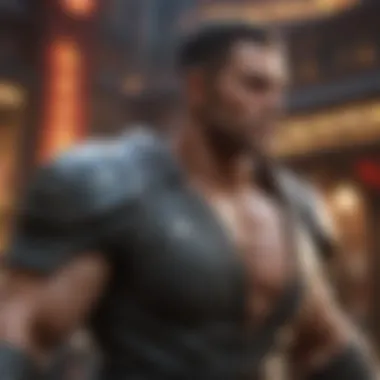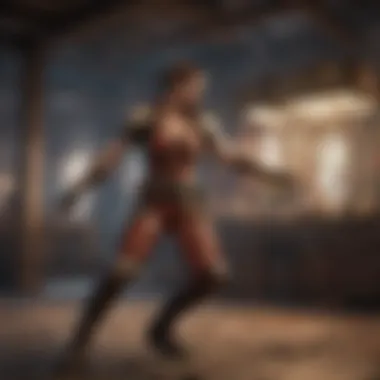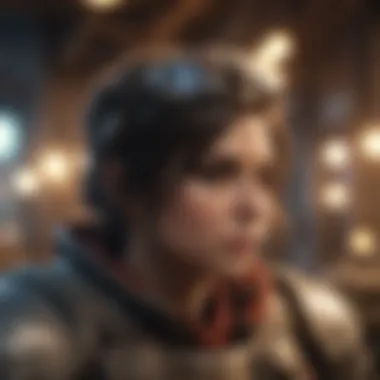Unveiling the Artistry: Crafting Intricate Fighting Games from Scratch


Overview of Building Fighting Games
Fighting games are a unique genre in the world of gaming, requiring meticulous attention to detail in both development and design. Every aspect, from character creation to gameplay mechanics, plays a pivotal role in shaping the player's experience. This overview sets the stage for diving deep into the intricate process of mastering the craft of building fighting games.
Character Creation
One of the fundamental pillars of developing a compelling fighting game is character creation. Each character must be meticulously designed, with unique traits, abilities, and visual aesthetics that resonate with players. From selecting fighting styles to determining special moves, every detail contributes to the overall diversity and depth of the game's roster.
Gameplay Mechanics
The backbone of any fighting game lies in its gameplay mechanics. From combo systems to frame data, the mechanics dictate the flow and strategy within matches. Balancing characters, movesets, and risk-reward ratios is a nuanced process that requires extensive testing and fine-tuning to ensure a fair and engaging experience for players.
Storytelling in Fighting Games
While gameplay mechanics are paramount, storytelling also plays a crucial role in immersing players in the game world. Developing a compelling narrative for a fighting game involves crafting character backstories, rivalries, and overarching plotlines that drive player engagement. Integrating storytelling elements seamlessly into the gameplay experience is key to creating a memorable and immersive journey for players.
Visual Design and Aesthetics
Visual design and aesthetics are integral to the success of a fighting game. From character animations to background environments, every visual element contributes to the game's overall immersion and impact. Attention to detail in character design, fluid animations, and vibrant visuals enhances the player experience, making the game visually appealing and captivating.
Competitive Gameplay and Esports
The rise of competitive gameplay and esports has significantly influenced the development of fighting games. Balancing gameplay for casual and competitive players, designing robust online features, and supporting the esports community are essential considerations for modern fighting game developers. Creating a dynamic and balanced competitive environment adds longevity and replay value to the game, fostering a thriving community of players and spectators.
Accessibility and Inclusivity
Ensuring accessibility and inclusivity in fighting games is imperative in creating an engaging and welcoming environment for all players. Implementing features such as customizable controls, tutorial modes, and diverse character representation broadens the game's appeal and allows a wide range of players to enjoy the experience. By prioritizing accessibility, developers can cultivate a more inclusive gaming community and showcase the diversity of the player base.
Innovations in Game Development
As technology advances and player expectations evolve, innovations in game development continue to push the boundaries of what is possible in fighting games. From incorporating virtual reality technology to exploring procedurally generated content, developers are constantly seeking new ways to enhance the player experience and set their games apart in a competitive market. Embracing innovation and staying attuned to industry trends are key factors in mastering the craft of building cutting-edge fighting games.
Conclusion
Mastering the craft of building fighting games is a multifaceted journey that requires a fusion of creativity, technical skill, and player-centric design. By delving into the nuances of character creation, gameplay mechanics, storytelling, visual design, competitive gameplay, accessibility, and innovation, developers can elevate their craft and deliver captivating experiences that resonate with players worldwide.
Introduction
When delving into the realm of building fighting games, one must acknowledge the intricate nature of game development. The introduction serves as the initial portal through which developers and gamers alike immerse themselves in the upcoming game's essence. It sets the tone for the entire gaming experience, creating anticipation and laying the foundation for what lies ahead. An effective introduction not only captures attention but also provides a glimpse into the core elements that make a fighting game truly engaging. Developers must carefully consider the balance between revealing enough to spark interest without giving away too much, maintaining a sense of mystery and excitement. In the context of this article, the introduction serves as the gateway to a profound exploration of the art of crafting immersive and dynamic fighting game experiences that resonate with players on a multitude of levels.
Understanding Fighting Games


Understanding fighting games is a crucial aspect of this comprehensive guide on mastering the craft of building fighting games. In the realm of game development, grasping the intricacies of fighting games is paramount to creating captivating and immersive gaming experiences. By dissecting the core elements and mechanics that define this genre, developers can effectively cultivate engaging gameplay and cultivate a devoted player base. Understanding the nuances of fighting games allows for the implementation of strategic depth, precise control mechanics, and an intense competitive environment that keeps players invested in the virtual world.
Evolution of Fighting Games
The evolution of fighting games traces back to the early days of arcade culture, where titles like 'Street Fighter' and 'Mortal Kombat' pioneered the genre. These classic titles laid the foundation for what would become a diverse and expansive landscape of fighting games. Over the years, advancements in technology have facilitated significant improvements in graphics, animations, and gameplay mechanics, pushing the boundaries of what can be achieved in the genre. With a rich history spanning decades, the evolution of fighting games showcases the iterative process of innovation and adaptation that has kept the genre thriving in the ever-changing landscape of gaming.
Core Components of Fighting Games
At the core of every fighting game lie essential components that shape the player experience. Elements such as character design, combat mechanics, and stage layouts play a pivotal role in defining the identity of a fighting game. The intricate balance between offense and defense, the variety of special moves and combos, and the uniqueness of character abilities are all crucial components that developers meticulously craft to ensure a rewarding and engaging gameplay experience. By mastering the core components of fighting games, developers can create dynamic and competitive gameplay that captivates players and fosters a loyal community around their game.
Popular Fighting Game Franchises
The world of fighting games boasts a multitude of popular franchises that have left a lasting impact on gamers around the globe. From iconic series like 'Street Fighter' and 'Tekken' to newer entries like 'Dragon Ball FighterZ' and 'Super Smash Bros.,' the diversity of gameplay styles and character rosters in these franchises cater to a wide range of player preferences. Each franchise brings its unique flavor to the fighting game genre, whether through intricate combo systems, diverse character rosters, or innovative gameplay mechanics. Studying the success and longevity of these popular franchises offers valuable insights into what makes a fighting game resonate with players and stand the test of time.
Character Design and Development
In the realm of game development, character design and development stand as a crucial pillar shaping the essence of any fighting game. This aspect governs the creation of personas that players will embody throughout their immersive gaming ventures. The intricacies of character design encompass not only visual aesthetics but also playability and narrative depth. Developers meticulously craft each character, focusing on elements such as appearance, personality, and unique abilities to offer players a diverse and engaging roster. Character design transcends mere aesthetics, providing players with a connective thread to the virtual world presented before them, enhancing immersion, and fostering emotional investment.
Creating Diverse and Unique Characters
Creating diverse and unique characters is a fundamental component of character design essential in captivating player interest. Diving deep into the creative process, developers must strive to break stereotypes and conventional archetypes, breathing life into characters that resonate with a diverse audience. Embracing cultural diversity, varied backgrounds, and distinct personalities allow for a rich tapestry of characters that offer something for every player. By infusing each character with a unique playstyle and backstory, developers cultivate a captivating gaming experience that transcends mere button inputs, enabling players to forge genuine connections with the virtual avatars they control.
Balancing Characters for Fair Gameplay
Achieving a delicate balance in character abilities and attributes is essential for ensuring fair gameplay and competitive integrity. Balancing characters involves meticulous fine-tuning of strengths and weaknesses, preventing any single character from overshadowing others. Developers must navigate the intricate landscape of game mechanics, adjusting variables to create a level playing field where skill and strategy reign supreme. Striking the balance between creativity and competitive viability is a challenging task, requiring thorough playtesting and data analysis to refine character capabilities without sacrificing diversity and uniqueness.
Character Progression and Customization
Character progression and customization offer players a sense of ownership and individuality within the gaming experience. By incorporating systems that enable players to tailor their characters to suit their playstyle, developers empower personal expression and strategic decision-making. From skill trees to cosmetic customization, these features add depth to the gameplay, incentivizing player investment and replay value. Balancing character progression to provide a sense of growth without compromising game balance is a delicate dance, often achieved through iterative design and player feedback loops.
Gameplay Mechanics and Combat Systems
Understanding Frame Data and Hitboxes
Delving deeper into the technical intricacies of fighting games leads us to the pivotal realm of Frame Data and Hitboxes. Within the domain of Gameplay Mechanics, these elements serve as the invisible architects dictating the outcome of in-game interactions. Frame Data determines the precise timing and efficiency of each move, enriching the combat experience with intricate details that affect strategy and execution. Simultaneously, Hitboxes define the vulnerable areas within which attacks land successfully, underscoring the importance of precision and tactical positioning during gameplay. The fusion of Frame Data and Hitboxes forms the bedrock of a balanced and skill-intensive combat system, shaping the virtual battles into a harmonious interplay of strategy, reflexes, and expertise.
Incorporating Combo Systems and Special Moves
The fusion of artistry and complexity unfolds as developers embark on the integration of Combo Systems and Special Moves within the gameplay landscape. These elements infuse fighting games with a layer of creativity and unpredictability, enabling players to unleash a myriad of devastating combinations and awe-inspiring techniques. Combo Systems amplify the fluidity of combat, allowing for seamless transitions between attacks and defenses that test the mettle of players at every turn. On the other hand, Special Moves add a touch of individuality and flair to each character, presenting a diverse array of offensive and defensive options that cater to varied playstyles. By skillfully weaving Combo Systems and Special Moves into the fabric of gameplay mechanics, developers craft a tapestry of excitement and challenge that enthralls players and defines the essence of the gaming experience.
Balancing Offensive and Defensive Strategies


Achieving equilibrium between Offensive and Defensive Strategies stands as a paramount goal in the development of compelling fighting games. The dynamic interplay between aggressive assaults and steadfast defenses forms the crux of strategic decision-making during gameplay, demanding a delicate balance to ensure fair and engaging combat scenarios. Creating an environment where both offensive juggernauts and defensive prodigies flourish requires meticulous attention to detail and a profound understanding of player psychology. By honing the art of balancing offensive pressure with defensive resilience, developers pave the way for a gameplay experience that rewards versatility, adaptability, and tactical acumen. Through the intricacies of offensive and defensive harmony, fighting games transcend mere button mashing, evolving into a strategic dance of wits and skill that keeps players on the edge of their seats.
Section5: Level Design and Environment
Subsection: Creating Dynamic and Interactive Arenas
In the realm of building fighting games, the significance of level design and environment cannot be overstated. These elements form the backdrop against which all the action unfolds, playing a pivotal role in not just aesthetics but also gameplay dynamics. Dynamic and interactive arenas bring a new dimension to battles, providing strategic advantages and challenges based on the players' interaction with the environment. The design of these arenas must cater to various playstyles, offering both offensive and defensive opportunities while ensuring a fair and engaging battlefield for all contenders.
Subsection: Utilizing Environmental Hazards and Stage Transitions
Embracing environmental hazards and stage transitions injects depth and complexity into the gameplay, requiring players to adapt swiftly and strategically to changing circumstances. Incorporating hazards like falling objects, electrified floors, or moving platforms adds layers of unpredictability and excitement to the matches, keeping players on the edge of their seats. Stage transitions further elevate the experience by seamlessly shifting combat from one area to another, showcasing the diverse range of challenges that fighters must navigate. By implementing these elements thoughtfully, developers can create a dynamic and captivating gameplay experience that keeps players engaged and enthralled.
Subsection: Incorporating Stage Music and Atmosphere
The auditory and visual components of a fighting game are equally crucial in enhancing the overall experience for players. Stage music sets the tone for battles, intensifying or calming the atmosphere based on the situation. The right soundtrack can evoke emotions, pump up adrenaline, or create a sense of urgency, influencing players' moods and combat strategies. Moreover, crafting a suitable atmosphere through background visuals, lighting effects, and thematic elements deepens the immersion and adds depth to the storytelling within the game. The marriage of stage music and atmosphere not only complements the gameplay but also elevates the player's overall engagement and connection with the game world.
Online Features and Multiplayer Gameplay
Online features and multiplayer gameplay play a pivotal role in the overall gaming experience. In the realm of fighting games, the implementation of robust online features can significantly enhance the longevity and appeal of a title. By enabling players to engage with others globally, online features broaden the scope of competition and offer a dynamic platform for skill development and interaction. The ability to seamlessly connect with other players, engage in matches, and participate in tournaments not only adds depth to the gameplay but also fosters a sense of community within the gaming landscape. Moreover, the incorporation of multiplayer aspects introduces new challenges and strategic opportunities, pushing players to adapt their tactics and improve their skills to compete at a higher level.
Implementing Netcode for Smooth Online Play
Ensuring smooth and stable online play is a critical aspect of developing a successful fighting game. Implementing efficient netcode lies at the core of providing players with a seamless online experience. Netcode governs how the game handles network communication, determining factors such as latency, synchronization, and overall responsiveness during online matches. By optimizing netcode implementation, developers can mitigate common issues like lag, delay, and desynchronization, thereby offering players a fluid and enjoyable online gaming experience. Striving for reliable netcode is essential to maintaining player engagement and satisfaction, as even minor networking issues can significantly impact gameplay quality and overall immersion.
Creating Ranking Systems and Tournaments
Introducing ranking systems and tournaments adds another layer of competitiveness and excitement to the multiplayer aspect of fighting games. Ranking systems evaluate and categorize player skill levels, providing a clear hierarchy that motivates players to improve and climb the rankings. Tournaments bring players together in organized competitions, showcasing their abilities and enabling them to measure their skills against others. By integrating these features, developers cultivate a more engaging and rewarding multiplayer environment, encouraging healthy competition and continuous skill development among players. Tournaments also serve as a platform for highlighting top players, fostering community engagement, and generating interest in the game's competitive scene.
Balancing Character Strengths for Competitive Play
Character balance is a crucial component of creating a fair and competitive gameplay experience in fighting games. Ensuring that each character possesses strengths and weaknesses that align with the game's overall design philosophy is essential for promoting diverse and strategic gameplay. Balancing character strengths involves fine-tuning attributes, move properties, and abilities to prevent any single character from dominating the competitive landscape. Developers must analyze gameplay data, gather feedback from players, and iterate on character designs to achieve a level playing field where skill and strategy reign supreme. By maintaining balanced character strengths, developers foster an environment where players can explore different playstyles, adapt to varying matchups, and engage in thrilling competitions based on skill and strategy.
Testing and Balancing
In the realm of designing fighting games, Testing and Balancing stands as a crucial phase that can determine the success or failure of the game. This process involves meticulously evaluating and fine-tuning various elements within the game to ensure a fair and engaging experience for players. Testing allows developers to identify any potential issues or imbalances, while balancing seeks to adjust character abilities, move properties, and overall gameplay mechanics to create a competitive environment. By emphasizing Testing and Balancing, game developers can enhance gameplay depth, cater to different playstyles, and maintain a high level of challenge necessary for player retention.
Conducting Playtesting and Feedback Sessions
One of the primary tasks within Testing and Balancing is conducting extensive Playtesting and Feedback Sessions. This involves gathering a diverse group of players to experience the game firsthand and provide valuable insights. Through playtesting, developers can observe how different players interact with the game, uncover potential exploits or weaknesses, and gather feedback on overall game balance. These sessions serve as a vital tool for identifying areas that require adjustment and fine-tuning to refine the gaming experience.
Adjusting Character Attributes and Move Properties


Adjusting Character Attributes and Move Properties is a meticulous process that directly influences the balance and competitiveness of a fighting game. Game developers must carefully analyze each character's strengths and weaknesses, adjust move properties such as damage, range, and speed, and ensure each character offers a balanced and unique gameplay experience. Balancing character attributes is essential to prevent any single character from dominating gameplay and to promote strategic diversity among players.
Fine-Tuning Game Mechanics and Difficulty Levels
Fine-Tuning Game Mechanics and Difficulty Levels involves honing the intricate aspects of gameplay to provide a compelling and challenging gaming experience. This process includes adjusting combo timings, hitbox properties, frame data, and overall game difficulty to cater to both casual and competitive players. By fine-tuning game mechanics, developers can create a balanced yet engaging gameplay experience that rewards skillful play and strategic decision-making, ensuring long-term enjoyment for players across various skill levels.
Art and Visual Design
Art and Visual Design play a crucial role in the development of fighting games, serving as the visual foundation that brings the game world to life. From character models to backgrounds, every visual element contributes to the overall experience of the game. Attention to detail in art and design is paramount, as it directly impacts the players' immersion and connection to the game. Visual aesthetics can make or break a game's reception, making it essential for developers to prioritize artistic quality.
Creating Stunning Character Models and Animations
Creating stunning character models and animations is a meticulous process that requires talent and technical expertise. Characters are the heart of a fighting game, serving as the player's avatar and embodying the game's theme. Designers must focus on unique characteristics, fluid movements, and expressive animations to make the characters memorable and engaging. Each model must be meticulously crafted to ensure smooth animations and lifelike interactions during gameplay.
Designing Vibrant and Engaging Backgrounds
The design of backgrounds in fighting games is more than just a visual backdrop; it sets the stage for intense battles and complements the characters' actions. Vibrant and engaging backgrounds can enhance the overall atmosphere of the game, immersing players in different settings and environments. Developers need to pay attention to detail, color palettes, and thematic coherence to create dynamic backgrounds that resonate with the game's narrative and aesthetic.
Implementing Special Effects and Particle Animations
Special effects and particle animations add a layer of dynamism and excitement to fighting games, elevating the visual experience for players. Whether it's explosive special moves, flashy attacks, or environmental effects, these elements enhance the overall impact of the gameplay. Implementing special effects requires a keen eye for visual effects design, animation principles, and technical integration. By carefully integrating special effects, developers can make combat scenes more engaging and visually impressive.
Marketing and Community Engagement
In the realm of building fighting games, Marketing and Community Engagement play a pivotal role in the success and longevity of a game. Effective marketing strategies not only elevate visibility but also cultivate a loyal community base. By strategically engaging with the gaming community, developers can establish a robust player base and foster a sense of belonging among players. Furthermore, community engagement allows for valuable feedback and insights that can inform future game updates and developments.
Promoting the Game through Trailers and Demos
Promoting a fighting game through trailers and demos is a critical component of the marketing strategy. Trailers serve as a visual teaser, offering glimpses of gameplay mechanics, character designs, and striking visuals to entice potential players. On the other hand, demos provide players with a hands-on experience, allowing them to gauge the gameplay mechanics, controls, and overall feel of the game. By leveraging trailers and demos effectively, developers can generate hype, increase anticipation, and attract a wider audience to their game.
Interacting with Fans and Gathering Feedback
Interacting with fans and gathering feedback is paramount in the development and refinement of a fighting game. Direct engagement with the player community not only instills a sense of transparency and trust but also allows developers to comprehend player preferences, concerns, and suggestions. By actively listening to fan feedback, developers can address issues, implement requested features, and tailor the gaming experience to meet player expectations. This iterative process of communication and responsiveness is key to maintaining a dedicated player base and fostering long-term game growth.
Organizing Events and Esports Competitions
Organizing events and esports competitions serve as a dynamic platform to showcase the competitive aspects of a fighting game. By hosting tournaments, developers can spotlight skilled players, elevate the game's visibility in the esports scene, and attract competitive gaming enthusiasts. Additionally, events provide an opportunity for fans to participate, engage with the community, and witness high-level gameplay. This interactive and competitive environment not only nurtures a sense of community but also elevates the fighting game to a competitive sport, driving engagement, and enthusiasm among players and spectators alike.
Conclusion
The conclusion of this extensive guide on mastering the craft of building fighting games serves as the culmination of a multifaceted journey into the intricacies of game development. As the essence of the entire article, the conclusion encapsulates the importance of meticulous planning and execution in creating compelling and immersive gaming experiences. Through a lens of critical analysis and creative exploration, this section not only summarizes the key insights but also reinforces the significance of each preceding topic.
In this final segment, readers are encouraged to reflect on the comprehensive nature of developing fighting games, understanding that it is not merely the sum of its parts but a harmonious blend of artistry and technical prowess. The conclusion acts as a bridge between theory and practice, reminding aspiring game developers of the dedication and innovation required to succeed in the competitive gaming industry.
Moreover, the conclusion prompts contemplation on the broader implications of game design, urging creators to push the boundaries of creativity while staying true to the core principles of game development. By emphasizing the iterative nature of game design and the iterative nature of game design and the importance of community feedback, this section underscores the collaborative aspect of game development, highlighting the value of continuous improvement and adaptation.
Ultimately, the conclusion serves as a testament to the passion and dedication of game developers worldwide, illustrating the transformative power of interactive storytelling and immersive gameplay experiences. It reinforces the idea that crafting exceptional fighting games is not just a technical craft but a profound artistic endeavor that shapes and enriches the gaming landscape.















